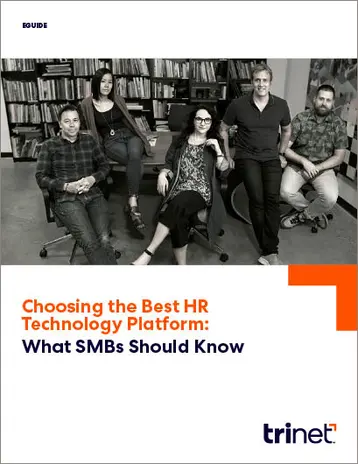SAAS Trends Point to More Use in HR Outsourcing

Table of contents
- 1.Top SaaS Trends
- 2.Increasing adoption of artificial intelligence (AI) and machine learning (ML)
- 3.Focus on employee experience and well-being
- 4.Mobile first
- 5.Integration and interoperability
- 6.More content marketing by SaaS companies
- 7.Low-code and no-code
- 8.Micro-SaaS
- 9.Democratization of HR technology
- 10.Increased focus on talent management
- 11.Data-driven decisions
- 12.Keeping up on SaaS Trends
Software as a service (SaaS) is a way of delivering software and applications over the internet, using a subscription-based business model. Before the emergence of cloud computing, HR software users had to buy and install their software themselves on their own computers or local servers. They also had to maintain, troubleshoot, and periodically update their software systems.
The advantages SaaS brings to the HR sector may include cost and time savings. The SaaS provider, not your company, provides and maintains the software. Your company may save on the upfront costs of purchasing software licenses and the ongoing costs of IT support and maintenance. SaaS can be also easier to scale up as your company grows. It’s generally easily accessible from the phone, tablet, or computer, which is especially convenient for remote workers. It may also enhance data security.
For all these reasons, SaaS for human resources has become increasingly popular with business owners, managers, and HR professionals. In 2023, the global SaaS-based human resource market was valued at $187 billion. It is projected to increase at a compound annual growth rate (CAGR) of 12% through 2029, when its anticipated market value will reach $373 billion.
Traditionally, SaaS has been used to help automate many HR functions, including payroll processing, benefits administration, onboarding, talent management, and time tracking. In the future, thanks to rapidly improving technology and changes in the way we work, SaaS will most likely offer even more in the HR sphere. And, as more companies learn about its advantages, its use will likely grow.
Top SaaS Trends
Let’s look at some of the top trends in human resources SaaS.
Increasing adoption of artificial intelligence (AI) and machine learning (ML)
The current trend of integrating AI into software applications is likely to accelerate as increasingly powerful AI models continue to be evolve. With AI, users of human resources SaaS will likely be able to optimize many of their HR functions, including talent acquisition, employee development, and performance management. AI-powered SaaS may also provide sophisticated capabilities, including natural language processing (NLP) and intelligent automation. AI-powered predictive data analytics may also give businesses the ability to use internal and external data to make better decisions.
Focus on employee experience and well-being
Using SaaS, businesses can enhance employee experience and well-being, which contributes to keeping employees engaged and satisfied with their jobs. This may help to reduce employee turnover caused by dissatisfied workers seeking opportunities elsewhere. Engaged employees are also more likely to be productive, contributing more to the company’s bottom line. SaaS can enhance the employee experience by providing personalized training and development, efficient onboarding, feedback in real time, and wellness initiatives.
Mobile first
Some employees are returning to the office, however working from home, for at least a portion of the workforce, appears to have become an accepted way of working in the digital economy. Companies need to be able to communicate effectively with their remote employees, as well as help them feel included in the company’s mission and culture. Teams that have members in different locations, and sometimes in different countries, are also an increasingly common feature of the modern workforce. SaaS that can be accessed on mobile devices may provide a solution.
A mobile-first strategy is especially helpful for making it easy for remote workers to stay connected to their teams. It’s projected that in the near future, almost 75% of the world’s population will access the internet only through their phones, according to a report published by the World Advertising Research Center. Even employees who spend long hours on their desktop or laptop computers eventually step away from their desks. Having SaaS on mobile means they can receive and send communications and access other SaaS functions anytime and anywhere.
Integration and interoperability
Companies often use multiple software systems that, combined, automate their HR functions and other administrative tasks and strategic needs. The SaaS trend now, though, is to combine or link up the separate systems to improve efficiency and bring all of a company’s data together. Through integration, everyone using the SaaS system has access to the synced information and the freshest data. TriNet API helps applications to integrate with the TriNet platform for easy data flow.
More content marketing by SaaS companies
A trend within the SaaS industry is a shift in the way that SaaS companies market themselves. Some companies are moving from pay-per-click ads to content marketing. This is especially useful for SaaS companies that offer micro-niche products. Content marketing works, in part, by targeting keywords that reflect the terms people use when searching the internet for information. SaaS companies with specialized niches have less competition for keywords relevant to their products. That makes content marketing a cost-effective way for companies to tightly focus their marketing resources.
Low-code and no-code
Traditionally, software development was a labor-intensive process, requiring programmers to produce reams of code. The trend in SaaS, however, is toward low-code and no-code platforms that helps to enable people who don’t have coding knowledge to create custom applications on their own. Drag-and-drop interfaces and pre-built templates can make it easier for non-technical employees to create software solutions that are precisely tailored to their company’s needs.
Small and mid-sized companies, especially, may benefit from this trend. Being able to create or modify applications at any time provides businesses with the agility they need to quickly respond to changing market conditions.
Micro-SaaS
Micro-SaaS is a software system designed to provide specialized service. It focuses tightly on business niches, bringing the power of cutting-edge technology to even the smallest companies.
In most cases, one person or a small team develops the software. For example, an micro-SaaS company may make it easier for a business to create a website. Another may be able to help with time management app that helps small and mid-size companies with invoices, budgeting and expense tracking.
Democratization of HR technology
The trend toward greater use of micro-SaaS is only one reason why access to sophisticated HR solutions is becoming more democratic. Thanks to SaaS platforms, startups and other small or medium-sized businesses can now access to advanced HR technology that, in the past, may have only been available to larger enterprise.
SaaS systems are generally cost-effective, provide scalability, and are easy to use, even for employees without technical knowledge. This makes them ideally suited for companies of all sizes. This democratic access to advanced technology is a disruption that fosters innovation.
Increased focus on talent management
A key way that businesses can gain a competitive advantage is by attracting, retaining, and developing outstanding employees. The trend suggests an increasing use of SaaS HR platforms for talent management and workforce optimization.
SaaS can help you:
- Identify gaps in the skills your business may need to achieve its goals
- Implement recruiting strategies
- Track applicants
- Onboard new employees
- Provide customized education and skills training tools
- Optimize employee feedback
Data-driven decisions
Advances in technology have led to another SaaS trend — using data analytics and AI to help with human resources decision making. These technologies may be able to do a deep dive into your data, identifying current needs and future trends within your workforce. You also can examine your industry as well as the local, national, or global economy as a whole. You may receive valuable insights into your employees’ engagement and performance that can help you:
- Fine-tune your HR practices
- Implement a growth strategy
- Improve your revenue model
Using data analytics also gives you the ability to analyze real-time data to make up-to-the-second decisions on changing internal or external conditions, giving your company a competitive edge. This works well with agile methodology and lets you jump on relevant market trends. In addition to its HR applications, the use of data analytics may help you improve the customer experience to increase your customer retention rates.
Keeping up on SaaS Trends
At TriNet, we help our customers thrive and grow. TriNet is a cloud-based SaaS that provides a comprehensive HR outsourcing solution for small and mid-sized companies. Our modern platform helps to automate your HR administrative tasks, improves your employees’ experience, and provides actionable people analytics. To find out ways that TriNet SaaS can help your business, contact us to schedule a conversation with our team.
This communication is for informational purposes only, is not legal, tax or accounting advice, and is not an offer to sell, buy or procure insurance.
This article may contain hyperlinks to websites operated by parties other than TriNet. Such hyperlinks are provided for reference only. TriNet does not control such web sites and is not responsible for their content. Inclusion of such hyperlinks on TriNet.com does not necessarily imply any endorsement of the material on such websites or association with their operators.

TriNet Team
Table of contents
- 1.Top SaaS Trends
- 2.Increasing adoption of artificial intelligence (AI) and machine learning (ML)
- 3.Focus on employee experience and well-being
- 4.Mobile first
- 5.Integration and interoperability
- 6.More content marketing by SaaS companies
- 7.Low-code and no-code
- 8.Micro-SaaS
- 9.Democratization of HR technology
- 10.Increased focus on talent management
- 11.Data-driven decisions
- 12.Keeping up on SaaS Trends





